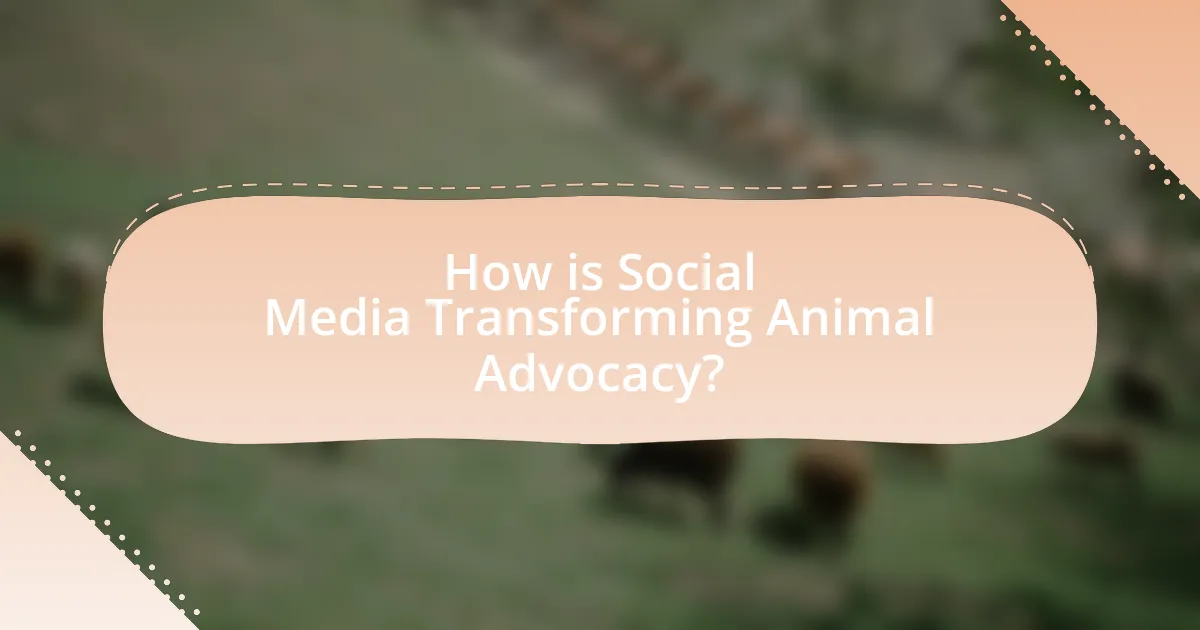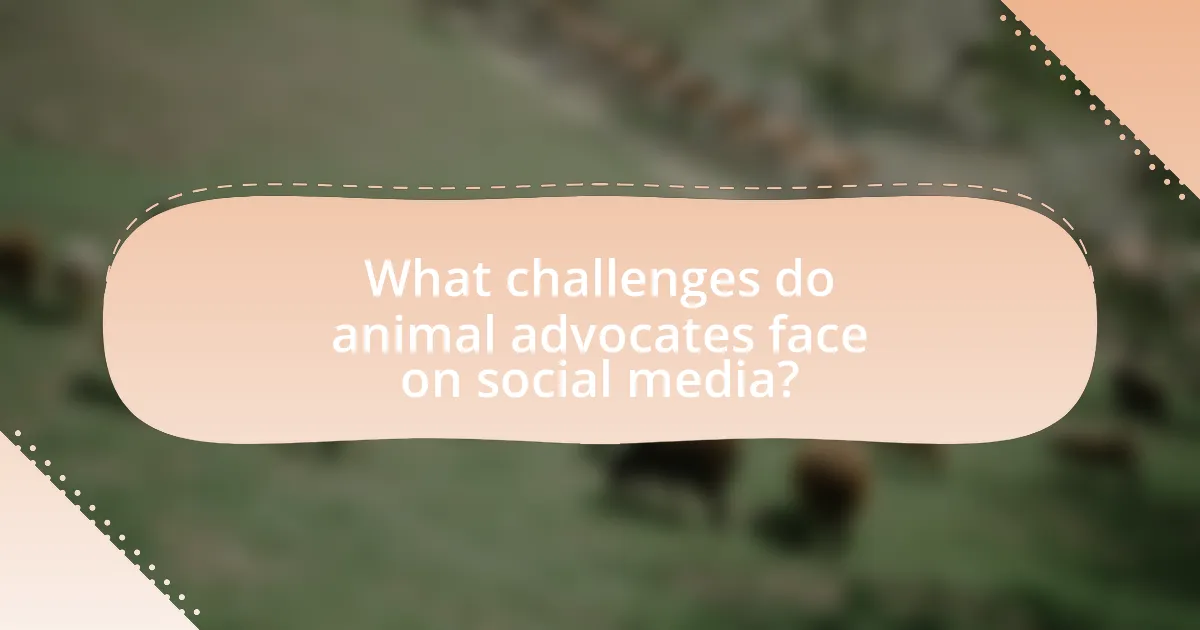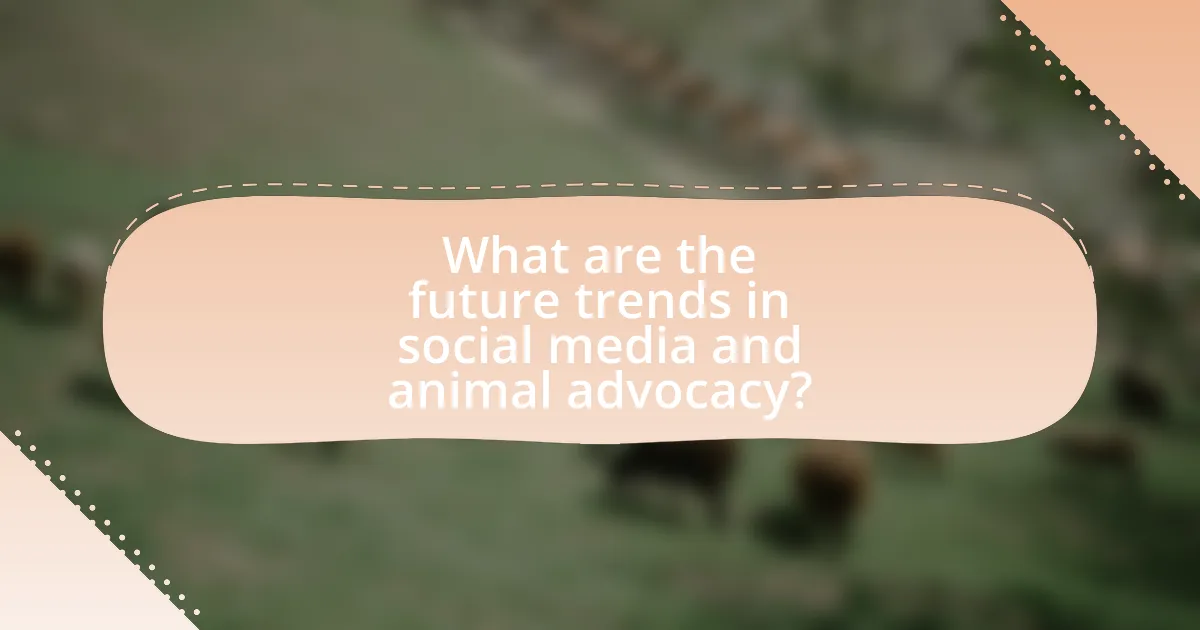The article examines how social media is reshaping animal advocacy by facilitating rapid information sharing, community mobilization, and increased awareness of animal welfare issues. It highlights the effectiveness of platforms like Facebook, Instagram, and Twitter in promoting campaigns such as #MeatlessMonday and #AdoptDontShop, which have significantly influenced public perception and behavior regarding animal rights. The discussion includes the role of social media influencers, the challenges advocates face, and the ethical considerations surrounding advocacy messaging. Additionally, it explores future trends in technology and data analytics that are likely to enhance the impact of animal advocacy efforts on social media.

How is Social Media Transforming Animal Advocacy?
Social media is transforming animal advocacy by providing a platform for rapid information dissemination and community mobilization. This shift allows organizations and individuals to share real-time updates on animal welfare issues, engage a broader audience, and mobilize support for campaigns. For instance, the viral nature of social media campaigns, such as the #MeatlessMonday initiative, has led to increased awareness and participation in animal rights movements, demonstrating a measurable impact on consumer behavior and policy changes. Additionally, platforms like Instagram and Twitter enable advocates to showcase rescue stories and educational content, fostering empathy and driving grassroots activism.
What role does social media play in raising awareness for animal rights?
Social media plays a crucial role in raising awareness for animal rights by providing a platform for advocacy, education, and community engagement. It enables organizations and individuals to share information, campaigns, and personal stories that highlight animal welfare issues, reaching a global audience rapidly. For instance, campaigns like #MeatlessMonday and #AdoptDontShop have gained significant traction on platforms like Instagram and Twitter, leading to increased public discourse and action regarding animal rights. According to a study published in the Journal of Animal Ethics, social media campaigns have been shown to increase public awareness and support for animal rights initiatives by 30% within targeted demographics. This demonstrates the effectiveness of social media as a tool for mobilizing support and fostering a community dedicated to animal advocacy.
How do social media campaigns influence public perception of animal welfare?
Social media campaigns significantly influence public perception of animal welfare by raising awareness and fostering engagement on animal rights issues. These campaigns utilize platforms like Facebook, Twitter, and Instagram to disseminate information, share personal stories, and mobilize support for various causes. For instance, the viral success of campaigns such as #MeatlessMonday and #AdoptDontShop has led to increased public discourse around vegetarianism and pet adoption, respectively. Research indicates that social media can amplify the reach of animal welfare messages, with studies showing that posts with emotional content generate higher engagement rates, thereby enhancing public empathy towards animals. This shift in perception can lead to behavioral changes, such as increased donations to animal charities or greater participation in advocacy events.
What are the most effective platforms for animal advocacy outreach?
The most effective platforms for animal advocacy outreach are Facebook, Instagram, Twitter, and YouTube. These platforms enable organizations to reach large audiences, engage supporters, and share impactful stories. For instance, Facebook’s user base exceeds 2.8 billion monthly active users, allowing for targeted advertising and community building. Instagram, with its visual focus, is particularly effective for sharing compelling images and videos of animals, which can drive emotional engagement. Twitter facilitates real-time communication and mobilization, making it ideal for advocacy campaigns and trending topics. YouTube serves as a powerful medium for storytelling, allowing organizations to create documentaries and educational content that can reach millions. Collectively, these platforms have transformed how animal advocacy organizations communicate and mobilize support, significantly increasing their outreach and impact.
Why is social media a powerful tool for animal advocacy organizations?
Social media is a powerful tool for animal advocacy organizations because it enables rapid dissemination of information and fosters community engagement. Through platforms like Facebook, Twitter, and Instagram, these organizations can share compelling stories, images, and videos that raise awareness about animal welfare issues, reaching millions of users instantly. For instance, the viral success of campaigns such as the Ice Bucket Challenge demonstrates how social media can mobilize support and funding for causes. Additionally, studies show that social media campaigns can significantly increase public participation in advocacy efforts, with a 2018 survey indicating that 70% of users are more likely to support a cause after seeing it on social media. This ability to connect with a broad audience and inspire action makes social media an essential asset for animal advocacy organizations.
How does social media facilitate community building among advocates?
Social media facilitates community building among advocates by providing platforms for connection, collaboration, and information sharing. These platforms enable advocates to engage with like-minded individuals, share resources, and organize events, thereby fostering a sense of belonging and collective purpose. For instance, Facebook groups and Twitter hashtags allow advocates to mobilize support for animal rights campaigns, share success stories, and discuss strategies, which enhances community cohesion. Research indicates that 70% of social media users feel more connected to their communities through these platforms, demonstrating their effectiveness in building networks among advocates.
What advantages does social media offer over traditional advocacy methods?
Social media offers several advantages over traditional advocacy methods, primarily through its ability to reach a wider audience quickly and cost-effectively. Unlike traditional methods, which often rely on print media or in-person events, social media platforms can disseminate information to millions of users instantly, facilitating rapid awareness and engagement. For instance, a study by Pew Research Center indicates that 69% of adults in the U.S. use social media, providing a vast potential audience for advocacy campaigns. Additionally, social media allows for real-time interaction and feedback, enabling advocates to engage directly with supporters and adjust strategies based on immediate responses. This dynamic interaction fosters community building and mobilization, which traditional methods struggle to achieve at the same scale.
How are social media influencers impacting animal advocacy?
Social media influencers are significantly impacting animal advocacy by raising awareness, mobilizing support, and driving donations for animal welfare causes. Their large followings enable them to reach diverse audiences, effectively spreading messages about animal rights, rescue efforts, and ethical treatment. For instance, campaigns led by influencers have resulted in increased visibility for organizations like the ASPCA and PETA, leading to higher engagement rates and donations. A study by the University of Southern California found that social media campaigns featuring influencers can increase public engagement by up to 60%, demonstrating their effectiveness in promoting animal advocacy initiatives.
What strategies do influencers use to promote animal welfare?
Influencers promote animal welfare through various strategies, including raising awareness, engaging their audience, and collaborating with organizations. They utilize social media platforms to share informative content about animal rights issues, often highlighting specific cases of abuse or neglect to evoke emotional responses. Engaging their audience through interactive posts, such as polls or Q&A sessions, fosters a community around animal welfare topics. Collaborations with animal welfare organizations amplify their reach, as influencers can leverage their follower base to promote campaigns, fundraisers, or adoption events, effectively mobilizing support for animal advocacy initiatives.
How can influencers effectively engage their audience on animal issues?
Influencers can effectively engage their audience on animal issues by utilizing storytelling, visual content, and interactive campaigns. Storytelling allows influencers to share personal experiences or impactful narratives about animals, which can evoke empathy and drive emotional connections. Visual content, such as high-quality images and videos of animals, captures attention and enhances message retention; studies show that posts with visuals receive 94% more views than those without. Interactive campaigns, like polls or challenges, encourage audience participation and foster a sense of community around animal advocacy. These strategies not only raise awareness but also motivate followers to take action, as evidenced by campaigns that have successfully mobilized support for animal welfare initiatives.

What challenges do animal advocates face on social media?
Animal advocates face significant challenges on social media, including misinformation, algorithm biases, and online harassment. Misinformation can spread rapidly, leading to public confusion about animal welfare issues, as seen in campaigns that misrepresent facts about animal testing or factory farming. Algorithm biases often limit the visibility of animal advocacy content, making it difficult for advocates to reach a broader audience; for instance, platforms may prioritize sensational content over educational posts. Additionally, online harassment from opposing groups can create a hostile environment, discouraging advocates from sharing their messages and engaging with supporters. These challenges hinder the effectiveness of animal advocacy efforts on social media platforms.
How do misinformation and negative narratives affect animal advocacy?
Misinformation and negative narratives significantly undermine animal advocacy by distorting public perception and eroding trust in advocacy organizations. For instance, false claims about animal welfare practices can lead to public backlash against legitimate organizations, reducing their ability to garner support and funding. A study by the Pew Research Center found that 64% of Americans believe misinformation is a major problem in society, which directly impacts how individuals view animal rights issues. Consequently, when negative narratives proliferate on social media, they can overshadow factual information, making it challenging for advocates to communicate their messages effectively and mobilize support for animal welfare initiatives.
What strategies can advocates use to combat misinformation online?
Advocates can combat misinformation online by employing fact-checking, promoting media literacy, and utilizing social media platforms for accurate information dissemination. Fact-checking involves verifying claims before sharing them, which helps to debunk false narratives. For instance, organizations like Snopes and FactCheck.org provide resources to confirm the validity of information. Promoting media literacy equips audiences with the skills to critically evaluate sources and discern credible information from misinformation. Research indicates that individuals with higher media literacy are less susceptible to believing false information. Additionally, advocates can leverage social media platforms to share verified facts and counter misinformation directly, as studies show that timely responses to misinformation can significantly reduce its spread.
How can advocates address backlash from opposing viewpoints?
Advocates can address backlash from opposing viewpoints by engaging in constructive dialogue and providing factual information to counter misconceptions. This approach fosters understanding and can reduce hostility, as seen in studies where open communication led to more positive perceptions of animal welfare initiatives. For instance, a survey by the Animal Welfare Institute found that when advocates presented data on humane treatment and environmental benefits, 70% of respondents shifted their views positively. By focusing on empathy and shared values, advocates can create a more receptive environment for their message.
What ethical considerations arise in animal advocacy on social media?
Ethical considerations in animal advocacy on social media include the potential for misinformation, the emotional manipulation of audiences, and the impact on animal welfare. Misinformation can arise when advocates share unverified claims or images, which may mislead the public about animal conditions or advocacy efforts. Emotional manipulation occurs when advocates use distressing images or narratives to provoke strong reactions, potentially leading to desensitization or backlash against the cause. Additionally, the focus on virality can overshadow the complexities of animal welfare issues, leading to oversimplified narratives that do not accurately represent the realities faced by animals. These ethical concerns highlight the need for responsible communication and critical engagement in animal advocacy on social media platforms.
How can advocates ensure responsible messaging about animal issues?
Advocates can ensure responsible messaging about animal issues by prioritizing factual accuracy and ethical considerations in their communications. This involves using verified data from reputable sources, such as scientific studies or animal welfare organizations, to support their claims. For instance, the American Society for the Prevention of Cruelty to Animals (ASPCA) provides statistics on animal cruelty that advocates can reference to substantiate their messages. Additionally, advocates should avoid sensationalism and misleading narratives that can distort public perception, focusing instead on constructive dialogue that promotes understanding and empathy towards animal welfare. By adhering to these principles, advocates can foster a more informed and compassionate discourse around animal issues.
What are the potential consequences of sensationalism in advocacy posts?
Sensationalism in advocacy posts can lead to misinformation and decreased credibility for the cause. When posts exaggerate or distort facts to attract attention, they can mislead the audience, resulting in a misunderstanding of the issues at hand. For instance, a study published in the Journal of Communication found that sensationalized content can lead to public skepticism and disengagement from important social issues, as audiences may feel manipulated or distrustful of the information presented. This erosion of trust can ultimately undermine the effectiveness of advocacy efforts aimed at promoting animal welfare.

What are the future trends in social media and animal advocacy?
Future trends in social media and animal advocacy include increased use of video content, the rise of influencer partnerships, and enhanced community engagement through interactive platforms. Video content, particularly live streaming, allows organizations to showcase rescue operations and educate audiences in real-time, fostering a deeper emotional connection. Influencer partnerships leverage the reach of popular figures to amplify advocacy messages, as seen in campaigns that have successfully raised awareness for animal rights issues. Additionally, social media platforms are increasingly incorporating features that promote community interaction, such as polls and Q&A sessions, which encourage active participation and mobilization of supporters. These trends are supported by data indicating that visual content generates 1200% more shares than text and images combined, highlighting the effectiveness of these strategies in reaching wider audiences.
How is technology shaping the future of animal advocacy campaigns?
Technology is significantly shaping the future of animal advocacy campaigns by enhancing outreach, engagement, and fundraising capabilities. Social media platforms enable organizations to reach wider audiences quickly, facilitating real-time communication and mobilization for causes. For instance, campaigns like the Ice Bucket Challenge have demonstrated how viral social media trends can raise millions for animal welfare initiatives. Additionally, data analytics tools allow advocates to tailor their messages based on audience demographics, increasing the effectiveness of campaigns. The integration of virtual reality experiences also immerses users in the realities faced by animals, fostering empathy and driving action. These technological advancements collectively empower animal advocacy groups to create more impactful and far-reaching campaigns.
What role will emerging platforms play in animal rights activism?
Emerging platforms will significantly enhance animal rights activism by providing new avenues for awareness, mobilization, and community building. These platforms facilitate real-time communication and allow activists to share information, organize events, and rally support more effectively than traditional methods. For instance, social media campaigns have led to increased visibility for animal rights issues, as seen in the viral success of campaigns like #MeatlessMonday, which encourages plant-based diets. Additionally, platforms like TikTok and Instagram enable visually compelling storytelling that resonates with younger audiences, driving engagement and fostering a sense of community among activists. The rise of crowdfunding platforms also allows for financial support of animal rights initiatives, further empowering grassroots movements.
How can data analytics enhance the effectiveness of advocacy efforts?
Data analytics can enhance the effectiveness of advocacy efforts by providing insights into audience behavior, preferences, and engagement patterns. By analyzing social media interactions, organizations can identify which messages resonate most with their target demographics, allowing for more tailored and impactful communication strategies. For instance, a study by the Pew Research Center found that 69% of adults in the U.S. use social media, making it a crucial platform for advocacy. Furthermore, data analytics can track the success of campaigns in real-time, enabling advocates to adjust their strategies based on performance metrics, such as shares, likes, and comments. This data-driven approach not only improves outreach but also fosters stronger community engagement and support for advocacy initiatives.
What best practices should animal advocates follow on social media?
Animal advocates should prioritize authenticity, engagement, and educational content on social media. Authenticity builds trust with followers, as advocates should share personal stories and experiences related to animal welfare. Engagement is crucial; responding to comments and messages fosters community and encourages dialogue about animal issues. Additionally, sharing educational content, such as facts about animal rights, rescue stories, and ways to help, informs the audience and raises awareness. Research indicates that posts with a personal touch and interactive elements receive higher engagement rates, enhancing the effectiveness of advocacy efforts.
How can advocates create engaging and informative content?
Advocates can create engaging and informative content by utilizing storytelling techniques, leveraging visuals, and incorporating data-driven insights. Storytelling captivates audiences by presenting relatable narratives that evoke emotions, making the content memorable. For instance, sharing personal experiences or case studies about animal rescue can foster a deeper connection with the audience.
Visuals, such as high-quality images and videos, enhance engagement by providing immediate impact and illustrating the message effectively. Research indicates that posts with visuals receive 94% more views than those without, highlighting the importance of incorporating compelling graphics.
Additionally, integrating data-driven insights, such as statistics on animal welfare or conservation efforts, adds credibility and informs the audience. For example, citing that over 6 million companion animals enter U.S. shelters annually can motivate action and awareness. By combining these elements, advocates can effectively engage their audience while providing valuable information.
What are the key elements of a successful social media campaign for animal advocacy?
The key elements of a successful social media campaign for animal advocacy include clear messaging, engaging visuals, targeted audience outreach, and measurable goals. Clear messaging ensures that the campaign communicates its purpose effectively, such as promoting animal welfare or raising awareness about specific issues. Engaging visuals, including high-quality images and videos of animals, capture attention and evoke emotional responses, which are crucial for driving engagement. Targeted audience outreach involves identifying and connecting with specific demographics that are likely to support animal advocacy, enhancing the campaign’s impact. Lastly, measurable goals allow organizations to assess the effectiveness of their campaigns through metrics such as engagement rates, shares, and donations, enabling continuous improvement. These elements are supported by studies showing that campaigns with strong visuals and clear calls to action significantly increase user engagement and support for animal causes.